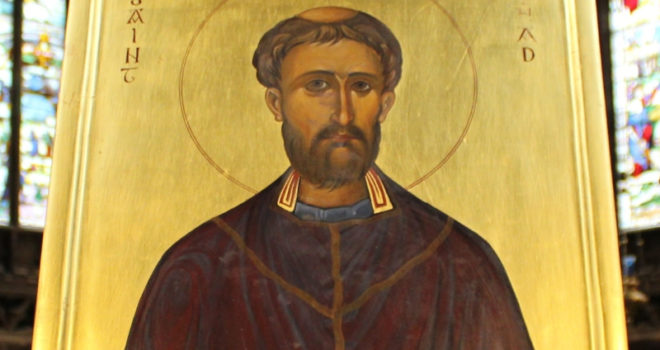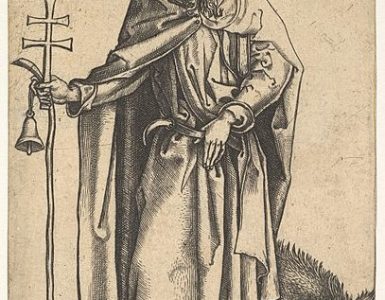Chad, also known as Ceada, was born in Northumbria around 620 A.D. He was the youngest of four brothers: Cedd, Cynibild, Caelin, and Chad. All the brothers became priests. Cedd later was made bishop of East Saxons (London).
Chad entered the monastery at Lindisfarne and studied under St. Aidain. St. Aidain encouraged his students to travel on foot, so whenever Chad traveled he did so on foot, stopping along the way to greet people and share the faith.
In 664 A.D., Chad’s brother, Cynibild, was stricken with the plague that was spreading throughout the country. Cedd, now Bishop of London, sent for Chad and asked him to replace his brother as Abbot of Lastingham. Cedd also fell victim to the plague and both brothers were dying.
Shortly after becoming Abbot, St. Wilfrid, who had been chosen to succeed Tudi, Bishop of Lindisfarne, went to Gaul for consecration. He stayed away for such a long period of time, however, that King Oswiu grew impatient and decided to nominate Chad as Bishop of York (which is where the Bishopric of Lindisfarne had been transferred). Chad was ordained by Wini, Bishop of Winchester, and assisted by two British prelates. According to writings by St. Bede, Chad devoted himself to all his duties, visiting his diocese on foot and preaching the gospel wherever he went.
All was well until St. Theodorus, Archbishop of Canterbury, arrived in England for a visit and decided that Chad’s Episcopal consecration was invalid. Chad’s reply to this was, “If you judge that I have not duly received the Episcopal ordination, I willingly resign this charge, having never thought myself worthy of it, but which, however unworthy, I submitted to undertake in obedience.” The Archbishop was charmed by Chad’s humility, but still felt that there were rites that were not carried out as they should have been, rendering Chad’s ordination invalid.
Chad humbly and graciously left his See and retired to his monastery. He was not there long, however, before the Bishop of Mercians died and Chad was asked to take his office. This diocese was large and had undergone much persecution under the rule of Maximianus Herculeus. Chad was the fifth bishop of Mercians. Because of Chad’s old age and the expanse of his diocese, Archbishop Theodorus forbade Chad to continue to travel by foot and gave him a horse. Chad refused to take the horse, so the Archbishop physically picked him up and set him on the animal. Chad relented and accepted the horse, which he found was a great benefit to his ministry.
During his episcopacy, Chad not only preached, evangelized and reformed the monastic life, but also built a cathedral on the site of the martyrdom of 1,000 Christians by the pagan Mercians. He also had wells dug so travelers could stop for a drink of water. It is said that miracles occurred at many of these sites.
The plague returned in 672 A.D. and this time Chad contracted the dreaded disease. On March 2, 672 A.D., Chad went to be with his Maker.
Lesson
St. Chad was probably best known for not being the Archbishop of York. He was elected and duly installed but some protested that his ordination was not valid. Instead of causing a scandal in the church, Chad withdrew in favor of the other candidate, Wilfrid. The objection was that some of the bishops that been involved with Chad’s ordination were in schism with the church at the time. St. Chad became better known to Americans in our own recent elections when there was so much controversy about “chads.” It is ironic that Saint Chad, too, was at the center of a controversial election over 1300 years earlier.
Prayer
We thank you, Father, for the humble example of St. Chad. We pray that we would always seek to serve, rather than to be served, to love rather than to seek praise, and to be a light in the darkness for others seeking truth. Amen.
Other Saints We Remember Today
- Blessed Charles the Good (1124), Martyr, Patron of counts and crusaders
Photo by Mariusz Matuszewski från Pixabay












